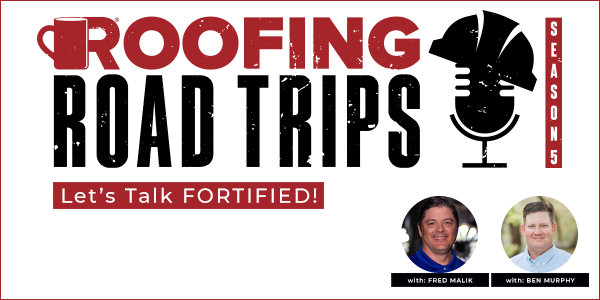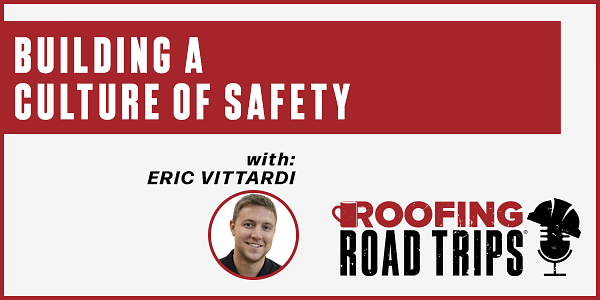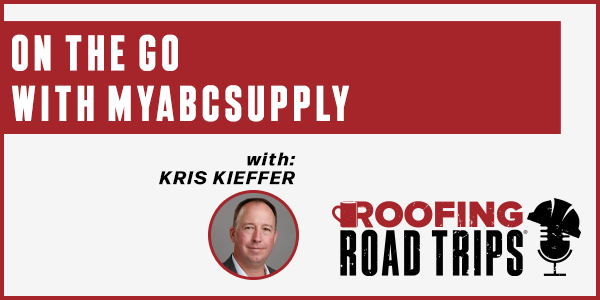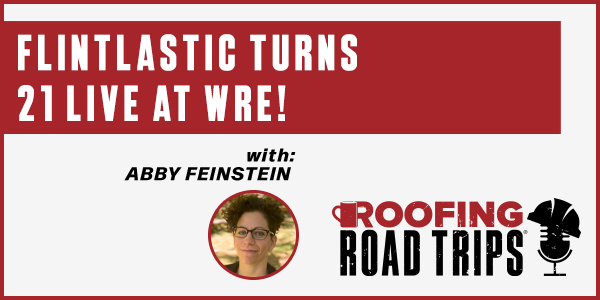Fred Malik & Ben Murphy - Let’s Talk FORTIFIED! - PODCAST TRANSCRIPT
November 30, 2023 at 12:00 p.m.Editor's note: The following is the transcript of a live interview with Fred Malik of IBHS and Ben Murphy of Ben Murphy Company. You can Read the transcript or Listen to the podcast.
Intro: Welcome to Roofing Road Trips with Heidi. Explore the roofing industry through the eyes of a long-term professional within the trade. Listen for insights, interviews and exciting news in the roofing industry today.
Megan Ellsworth: Hello everyone. My name is Megan Ellsworth here at Rooferscoffeeshop.com, and this is Roofing Road Trips, and I am tripping over to say hi to the pals at IBHS. And we're going to be talking about FORTIFIED by IBHS today. I'm super excited to have Fred Malik and Ben Murphy. Hi gentlemen, how are you?
Fred Malik: Hi, Megan, how are you?
Ben Murphy: Hey Megan, how are you?
Megan Ellsworth: Doing well. I'm excited to hear what you guys have to say. Let's dive right in. And Ben, why don't you start us off? Introduce yourself.
Ben Murphy: Yeah. My name is Ben Murphy. I own Ben Murphy Company, located here in Foley, Alabama. We've been in business almost 20 years, specialized in FORTIFIED new construction and FORTIFIED roofing in Louisiana, Mississippi and Alabama.
Megan Ellsworth: Very nice. Wow. Fred, how about you? Tell us a little bit about yourself.
Fred Malik: Yeah, sure. So, my name's Fred Malik. I'm the Managing Director of the FORTIFIED Program here at IBHS. I've been with IBHS for 15 years, and prior to that, I was a building contractor and built in the mid-Atlantic states down in here, into Florida, and then over into Texas.
Megan Ellsworth: Awesome. Very cool. Wow. You guys both have a wide range of states under your belts.
Fred Malik: We do.
Megan Ellsworth: So, let's talk about some of the research that led to this need for a FORTIFIED standard.
Fred Malik: Yeah. So, IBHS has been a research organization and an insurance trade association for 40 years. But in 2010, we had a sort of a groundbreaking addition to our suite capabilities, and that was the opening of our research center in South Carolina. There we have a giant wind tunnel on it and enables us to be able to look at entire homes and roof systems, and subject them to things like Category 3 winds, hail, wildfire, wind-driven rain, all kinds of different things. And that really gave us a unique perspective of looking at particularly roof systems and roof coverings, and how they can work together to really reduce the kinds of losses that people see from things like hurricanes or severe convective storms in inland parts of the country. And as we were doing research along those lines, we had an existing FORTIFIED program that was sort of everything in the kitchen sink.
We tried to make sure that every potential vulnerability got taken care of. That program was called FORTIFIED for Safer Living. But what we learned in our research was, there are ways for people to meaningfully change their risk profile and improve the durability of their home by focusing on specific systems that have specific types of vulnerability to a high wind and wind-driven rain. And it turns out that roofs are like the leading system that needs attention. And so, we focused a lot of our efforts there and packaged up our science into the FORTIFIED standard, which tends to go just a little bit above code in a few key areas, and it's made a lot of difference in places like Alabama and North Carolina and elsewhere.
Megan Ellsworth: Wow, that's so cool that you can subject these houses and the roofs to all these different circumstances, and kind of scary too, all those winds in one spot. So, what are some of the standards that, for FORTIFIED, that you all have put together?
Fred Malik: Yeah. So I think, for today's sake, we'll focus primarily on the roof. Every FORTIFIED home in the United States, and now there's nearly 60,000 of them, every home in the United States that carries the FORTIFIED label, has a FORTIFIED roof on it. And there are basically three primary things that we focus on when it comes to the roof. We want to nail it down, we want to seal it up, then we want to lock it in. What we mean by nailing it down is, we want to make sure that the roof deck, whatever surface the roof covering is ultimately going to be affixed to, is solidly attached to the roof framing. And so, we make sure that the roof decking is properly attached, or at least attached to the FORTIFIED standards. And there, we require folks like Ben to use ring shank nails at a specific nailing pattern to keep that roof deck attached.
Once we do that, then we want to make sure that that roof deck is sealed up. Why do we care about that? Well, 90% of the insured claims that are filed following a high wind event involves some sort of roof cover damage. So, once the roof cover goes, now you can start to have access points for the water to get in through the roof decking. And so, we've come up with a set of different sealed roof deck techniques that folks like Ben can use to eliminate those pathways for water.
And those can be adjusted or used based on whatever specific type of roof covers being used, whether it's shingles, metal roof, tile, cedar shakes and shingles, whatever. We've got several different ways that you can get to a sealed roof deck. But basically, what we're trying to do is cover the seams. Where the roof deck pieces come together, if they aren't covered with a durable product, then that's where the water can migrate in and we can really start to see homes that don't have substantial structural damage have large enough losses and large enough damage that people can be forced out for weeks or months.
And then, the last thing I mentioned was locking it in, and that's really paying attention to the perimeter of the roof. We, and along with a lot of other folks have been able to verify that the highest pressures, the largest load that a roof is going to see in a high wind event is going to be at the perimeter. And so, we pay special attention to how roof cover systems are installed around the edges. And those are the three basic things that you find in the FORTIFIED roof standard.
Megan Ellsworth: Very cool. Ben, what are some of the results that you're seeing after adopting this FORTIFIED standard?
Ben Murphy: So, in 2015, we started doing 100% of our projects in the FORTIFIED, and we kind of had to take this on the belief that the IBHS, with their engineering, everything would result in it. Well, in 2010, we had our first lab case study here with Hurricane Sally, which, where we live here, we had a direct hit. And thank goodness all the houses that we did, we had zero damage from the roof systems other than we had a couple of trees go through roofs, but there was nothing we could do about that. But-
Megan Ellsworth: Yeah.
Ben Murphy: ... Yeah, we've got several neighborhoods here in Orange Beach that had FORTIFIED roofs that we had done prior to the storm, and there's houses right next door that had complete roof failures. So, that was a really good test, at least for me to say, "Hey, this program really, really works." And I know the IBHS uses some of those photographs in their marketing and stuff, but that was the really eye-opener for us. And we knew we were doing a good thing, but once we saw the results after Hurricane Sally, it was a no-brainer from here on out.
Megan Ellsworth: Wow. Wow. Yeah, that's crazy. I mean, that's what you want to hear is the only way your roof is failing is if a tree falls into it.
Ben Murphy: Yeah.
Megan Ellsworth: What are some other successes that you've seen in this program in Alabama, and some of the benefits from choosing to use the FORTIFIED program?
Ben Murphy: Well, especially here in Alabama, the state of Alabama has mandated an insurance savings program for admitted carriers that, with each level of fortification, whether it's FORTIFIED roof, FORTIFIED silver or FORTIFIED gold, you get anywhere from 25 to 50% off your homeowner's policy, which, that was really kind of the driving force here in Alabama, getting customers to really jump off and get this program going. So, not only are they having a safer home from storms, but they're also able to save money on their homeowners' insurance,
Megan Ellsworth: Which is always a plus.
Ben Murphy: Yeah.
Fred Malik: Yeah. So there's... So, Alabama sort of led the way on that, and there are now five states that have mandated or regulatory requirements for FORTIFIED discounts off of property insurance, including a state like Oklahoma, which has some pretty high property insurance rates, the highest in the country away from the coast. In addition, Ben also participates in another success story, multiple ones now. But Alabama also led the way in creating an opportunity for folks to get some assistance on replacing their existing roof with a FORTIFIED roof. And so, Alabama has a grant program called Strengthen Alabama Homes.
Shortly thereafter, North Carolina, an organization up there called the North Carolina Joint Underwriting Association, followed suit. They also have a grant program. Now, Louisiana came on board in October of this year and is also issuing grants there. So, all told, there's about $50 million a year between those three grant programs available for homeowners to invest in strengthening their roofs.
So, that's been a huge deal. Minnesota actually is going to also introduce a FORTIFIED roof program, a roof grant program next year. So, we're seeing that as a mechanism to help people access additional capital to bridge the gap between a standard roof and a FORTIFIED roof. And lastly, I'll just say that, similar to what we saw in Hurricane Sally, we've had about 95% of the FORTIFIED inventory around the country experience, one, landfalling, at least one landfalling hurricane or significant wind event. A 30% reduction in the likelihood that you would have a claim, so your risk of having a claim as a result of a storm is cut by a third.
Megan Ellsworth: Wow.
Fred Malik: If you do have a claim, the value of that claim is likely to be around 25% less than if you had a non-FORTIFIED roof. So, we are seeing that consistently happen, whether we're talking about Alabama or North Carolina or elsewhere.
Megan Ellsworth: Wow, that's incredible. A third. That's amazing. So, you just talked about Louisiana just adopted a similar grant program. How has that been received in states that are bringing this in?
Fred Malik: Yeah. I'd say from a... Ben can talk a little bit more based on his experience. He talks directly to consumers. But we've seen a significant amount of demand for it.
Megan Ellsworth: Wow.
Fred Malik: When people heard that this was coming, there was a lot of interest from a contractor perspective. And certainly homeowners, anytime money is made available, those grants get applied for and committed within hours of them being made available. So, there's quite a few people out there that would like to see their roofs perform better in the next storm, and when they have access to additional resources, they jump right on board. Ben, what's your experience been?
Ben Murphy: Yeah. So, here in Alabama, it's been around a while. So, FORTIFIED is a household name. Everybody here, insurance agents, real estate agents, everybody knows FORTIFIED. I mean, when you're buying a house, if all things being equal, one's FORTIFIED, one's not, they're going to go FORTIFIED all the time. So, just like any other program, it took a little while to get the wheels rolling, but once the wheels started rolling, it just started snowballing.
So here in Alabama, it is a real big, big thing, at least on the coastal side, and it's moving statewide. But as far as Louisiana, yeah, it's just getting started over there. People are starting to learn about it. Insurance agents are starting to tell these homeowners, "Hey, we can get you this grant program," which is $10,000 over there, and 10,000 towards your roof is a really good deal. So that's, the money part is peaking these homeowners interest more than the benefits of it, but they're learning the benefits of it when they start studying it. So, in the long run, yeah, Louisiana is just going to be just like Alabama. It's going to be a very known word over there, FORTIFIED, and allow people to live in safer homes.
Megan Ellsworth: That's amazing. So, when the homeowners apply for the grant and they get approved, who's the contractor that is doing that roof?
Ben Murphy: So, the way it works is, you can, once you get in the program in Louisiana, you have to hire a third-party evaluator, which this person will come out and basically document everything on the house. What has to be done to bring that house to the FORTIFIED standard? So, every house is different. There's different requirements. So basically, they make us a checklist of, "Hey, we've got to put a sealed roof deck on. We've got to put gable vent covers, whatever it may be, to achieve the FORTIFIED standards. So, once the evaluator gets their evaluation done, then the homeowner has to select contractors to get bids.
And then, that's where we come in. We get the evaluation that says, "Hey, this is what we've got to do." We'll go out and inspect the house, make sure everything does and we'll submit a bid to the homeowner for the work to be done. And then, of course, once we're selected as a contractor, we'll do the work. The evaluator will document everything and submit it to the IBHS for the FORTIFIED Certificate.
Megan Ellsworth: Wow. How does a contractor become FORTIFIED certified?
Fred Malik: Yeah, because I was just going to sort of touch on that a little bit.
Megan Ellsworth: Awesome.
Fred Malik: We do have a process using the third-party evaluator that any roofer can participate and successfully install FORTIFIED roofs, but it tends to go much smoother if the roofing contractors go through our training. We have training available at our website called fortifiedwise.com. There is roofing contractor training there for hurricane prone areas and for high wind and hail prone areas. So, if you're listening to this and you happen to be in an inland state, Arkansas, Wisconsin, Minnesota, Virginia, something like that, we have a program for you as well. It's not just a coastal program.
And one of the other things that we're finding too is, as these entities, whether it's the Louisiana Department of Insurance, the Alabama Department of Insurance, NCJUA in North Carolina, as these entities are pulling their capital together and standing up these grant programs, one of the requirements that they have is that for roofers to be eligible to participate in their program, they have to complete FORTIFIED training and they have to be able to demonstrate that they've successfully done that.
And so, we work really hard to try and make sure that people have access to that. Our training is all now available online. It's available 24 hours a day, 7 days a week, 365 days a year. We try to keep the cost down low too. So, if you want to have your contractor, if you want to have your installers or your sales people trained, it's $100 per person to go through the course. And if you want to have them actually certified, there's an additional $50 to take the exam. And then, once a contractor does that, they not only get documentation that they've successfully completed the course, but if they follow all the certification requirements, then they become listed in our directory. And that's how entities like the departments of insurance verify that they are certified by us. So they go through our directory and they can see listed contractors there, and that also becomes a lead source for the general public to find roofing contractors like Ben.
Megan Ellsworth: Oh my gosh. And I mean, $150, that's really not, in the grand scheme of things, that's not a lot to get you or a crew member or all your crew certified. And that's bringing in more leads for your business as well. So, this is really, really amazing. Say again where they can go learn more about how to get certified?
Fred Malik: Yeah. So, the direct link to the training platform is called fortifiedwise.com. And if somebody just wants to understand a little bit more about what's in the program and see some resources that we have from a marketing perspective for roofing contractors, you can also check us out at fortifiedhome.org. And there we have all our technical resources, all of our marketing resources. So, there's lots of good information up there. It's all available, all the documentation is available for free.
One of the things that it's important for people to understand, IBHS is a nonprofit. FORTIFIED is not a profit center for us. Our interest is in trying to help as many people live underneath FORTIFIED roofs as possible, to reduce the likelihood that they're going to have a disruptive loss as a result of a storm. And so, that's how we get measured. I get measured by how many people live under FORTIFIED roofs. So, that enables me to keep all the costs that we're talking about, the training costs and the designation costs as low as we possibly can, so that the focus can be on investing money in getting the right materials and in the best contractors on your roof.
Megan Ellsworth: This is so amazing. Wow. Really, really great information. I hope everyone out there listening goes and learns more on their website, that you can also go to the IBHS directory on rooferscoffeeshop.com to learn more about the certification, the standards of the FORTIFIED roof, and more about just IBHS as well. Thank you so much for chatting with me. Anything else to add before we sign off?
Ben Murphy: The only thing I can say is, this is an absolute great program for our business, for the people. Hopefully, states will start adopting this throughout the US and let these homeowners live under protected roofs.
Fred Malik: Yeah. And I think that Ben is a really good example of a roofing contractor looking for opportunities to go beyond what the basic code requirements are. And we participate in the codes process, the codes making process. We provide subject matter expertise. But part of the reason why we have the FORTIFIED program is that, for contractors like Ben who really want to take care of their customers and add as much value in their product as they possibly can, we give them an opportunity to take the advantage of the science that we do and not have to be a scientific expert. They can just take what we've been able to do and then apply it to their trade. And so, it really is a great way for roofing contractors to distinguish themselves and separate themselves from their competition.
Megan Ellsworth: It is. And everyone deserves to live under a dry roof, keeping them, their family members, their loved ones, their belongings safe and dry and hurricane free.
Fred Malik: Couldn't agree more.
Ben Murphy: Yeah.
Megan Ellsworth: Thank you both so, so much for joining me today on Roofing Road Trips. This has been a blast. I will... I don't know where I was going with that. This has been a blast. It's awesome. Everyone, make sure to go to the IBHS directory on rooferscoffeeshop.com, as well as go to their website. This will all be linked below in the show notes. And gentlemen, thank you again. This has been amazing.
Fred Malik: Well, thank you. Appreciate it, Megan.
Ben Murphy: Thank you, Megan.
Fred Malik: Nice to talk to you again, Ben.
Ben Murphy: All right. Good to see you, Fred.
Megan Ellsworth: Awesome. This has been Roofing Road Trips. We will be seeing you next time on the road. Awesome. That was easy-breezy.
Outro: Make sure to subscribe to our channel and leave a review. Thanks for listening. This has been Roofing Road Trips with Heidi from the rooferscoffeeshop.com.
























Comments
Leave a Reply
Have an account? Login to leave a comment!
Sign In